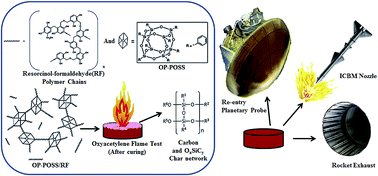Hybrid caged nanostructure ablative composites of octaphenyl-POSS/RF as heat shields
Abstract
A novel hybrid three dimensional thermosetting resin of resorcinol formaldehyde (RF) modified with different wt% of octaphenyl-polyhedral oligomeric silsesquioxane (OP-POSS) were successfully synthesized via facile in situ polymerization technique to form resol-type OP-POSS/RF ablative heat shielding material for thermal protection system (TPS). Ablation characteristics were investigated by exploring ablation rates in terms of dimensional change and mass loss that occurred after the samples were tested by a cheap yet effective oxyacetylene flame test. Linear and mass ablation rates of specimens ablated at 3000 °C for 60 s at a heat flux of 8.5 MW m−2 reduced by 70% and 30%, respectively. The rates as low as 0.016 mm s−1 and 0.059 g s−1 were noted with an exceptionally low back face temperature, which remained below 150 °C throughout the duration of the ablation test. The improved ablative properties of OP-POSS/RF can be attributed to the formation of an interconnected network of nanospheres, insulating the turbostratic carbonaceous char and ceramic char network of OxSiCy, which effectively blocks oxygen from attacking the matrix. X-Ray Diffraction pattern confirms the formation of insulative, carbonaceous char upon resin pyrolysis with peaks at 24° and 44° corresponding to (002) and (100). The FTIR signature showed peaks at 1501 (Si–CH![[double bond, length as m-dash]](https://www.rsc.org/images/entities/char_e001.gif) CH2), 1375 (Si–CH3), 1090, 555 (Si–O) and 794 (Si–C) cm−1, which addressed the presence of the OxSiCy network. A maximum char yield of 59.2% and lowest density of 1.08 g cm−3 was achieved for RF with 3 wt% of OP-POSS. An improved char retention property of specimens were supported by post-test FESEM images of the surface ablated for 300 s, which revealed an interconnected broccoli-like pattern of char. Atomic Force Microscopy images were studied to understand the surface roughness of a specimen before and after the ablation test. Contact angle data provided evidence for formation of a hybrid protection layer on the nanocomposite's surface. The thermal model and energy balance equation was suggested for the exchange in heat energies occurring at the surface. This study justifies the competency of RF to replace conventional phenol formaldehyde (PF) and the use of OP-POSS/RF as an effective ablative composite employed as heat shields in re-entry vehicles.
CH2), 1375 (Si–CH3), 1090, 555 (Si–O) and 794 (Si–C) cm−1, which addressed the presence of the OxSiCy network. A maximum char yield of 59.2% and lowest density of 1.08 g cm−3 was achieved for RF with 3 wt% of OP-POSS. An improved char retention property of specimens were supported by post-test FESEM images of the surface ablated for 300 s, which revealed an interconnected broccoli-like pattern of char. Atomic Force Microscopy images were studied to understand the surface roughness of a specimen before and after the ablation test. Contact angle data provided evidence for formation of a hybrid protection layer on the nanocomposite's surface. The thermal model and energy balance equation was suggested for the exchange in heat energies occurring at the surface. This study justifies the competency of RF to replace conventional phenol formaldehyde (PF) and the use of OP-POSS/RF as an effective ablative composite employed as heat shields in re-entry vehicles.


 Please wait while we load your content...
Please wait while we load your content...